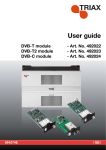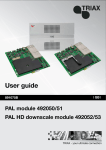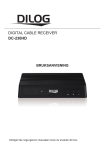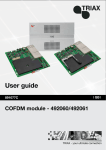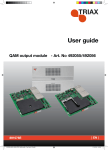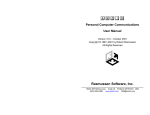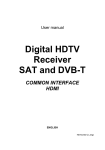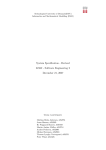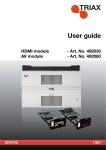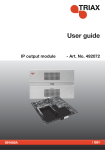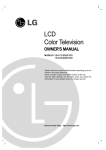Download Triax C-HD207 CX_V.0183_englisch_D.docx
Transcript
Content Triax x C-HD D207 Digital Cable-TV V Receiverr 305207, 305208 3 s Guide Users 1 Content Content Content ....................................................................................................................................... 2 General instructions ................................................................................................................... 3 Make a contribution to environmental protection ....................................................................... 3 Safety Instructions ...................................................................................................................... 4 Cleaning and care ...................................................................................................................... 4 Control elements, front and rear panel ....................................................................................... 4 Connecting the receiver ............................................................................................................. 6 Remote control ........................................................................................................................... 7 Initial installation ......................................................................................................................... 8 Operating the receiver ................................................................................................................ 9 EPG – Electronic Programme Guide ....................................................................................... 11 Settings .................................................................................................................................... 11 Settings – Receiver setup ................................................................................................... 12 Settings – Picture ................................................................................................................ 13 Settings – Sound................................................................................................................. 14 Settings – Subtitle ............................................................................................................... 15 Settings – OSD Configuration (Option) ............................................................................... 15 Settings – Parental lock ...................................................................................................... 16 Parental lock – device lock ................................................................................................. 16 Parental Lock – changing the PIN ...................................................................................... 16 Installation ................................................................................................................................ 17 Installation – channel search .............................................................................................. 17 Manual channel search ....................................................................................................... 18 Installation – Factory reset .................................................................................................. 18 Installation – Software download ........................................................................................ 19 Installation – Smartcard Reader (Option) ........................................................................... 21 Channel list............................................................................................................................... 22 Channel list – Edit main list ................................................................................................. 22 Channel list – Edit favourites list ......................................................................................... 22 Channel list – Delete all channels ....................................................................................... 22 Timer ........................................................................................................................................ 23 Timer – record timer............................................................................................................ 23 Information ............................................................................................................................... 24 Videotext .................................................................................................................................. 24 Connection of external mass storage device (option) .............................................................. 25 2 List of recordings ...................................................................................................................... 26 Operating the external mass storage device (Option) .............................................................. 27 Recording............................................................................................................................ 27 Timeshift function ................................................................................................................ 27 Playback ................................................................................................................................... 28 Choosing the audio channel for recordings ........................................................................ 28 Fast forward and rewind ..................................................................................................... 28 Operating the hard disk – setting and managing markers .................................................. 29 Using serial interface ................................................................................................................ 29 Trouble-shooting ...................................................................................................................... 30 Technical data .......................................................................................................................... 31 General instructions Warranty The period of warranty starts when buying the device. Please verify the exact date by sales check, delivery note, invoice, etc. Keep the documents carefully. Our warranty service refers to our warranty terms valid at the time of buying the apparatus. In case you require technical service please take or send the device to your specialised dealer. The unit is labelled with the CE-sign and therefore conforms to the general requirements of the European guidelines. The Declaration of Conformity is found in the later part of this manual Make a contribution to environmental protection Do not throw batteries into domestic waste. As a consumer you are obliged to return used batteries. You can bring them to a public collection station in your commune or elsewhere where batteries of the same type are sold. The following signs can be found on batteries including harmful substances: Pb = battery includes lead Cd = battery includes cadmium Hg = battery includes mercury Hints for disposal If your device is once disused you should not just throw it into domestic waste. Surely there is a collecting point for old devices where it can be collected and recycled. 3 Safety Instructions Safety Instructions Before installing your digital receiver, all security and operating instructions should be read carefully. The User’s Manual should be retained for future reference. All operating and using instructions should be followed. Never allow children to operate this electrical device without supervisor. ENVIRONMENTAL CONDITIONS Protect the receiver against humidity, heat and cold. Allow 10cm space around the receiver for sufficient ventilation. Do not cover the receiver’s ventilation openings with items like newspapers, tablecloths, curtains, etc. . Do not place any objects filled with liquids, such as vases, on the digital receiver. Take care that no foreign bodies or liquids are getting into the device. Do not expose the digital receiver to dripping or splashing liquids. CONNECTING TO MAINS SUPPLY (SAFETY FEATURE!) Only connect the original mains adapter to a well reachable mains supply connector 230V~ 50Hz only. Do not tilt, do not use disproportionate power and do not damage the receiver’s power connector and its electrical connections when connecting the power cord. If the mains adapter should fail to fit, contact your supplier. FAILURE If the mains adapter or the power connector or its electrical connection is damaged, immediately unplug the mains adapter from the mains supply connector. Do not try to open or repair the mains adapter or the receiver on your own! Service must be carried out only by experts at a proper service centre. If replacement parts are required, only original components are allowed to use. The use of unauthorised components may result in risk of fire and electric shock. Cleaning and care Before cleaning, unplug the device from the mains adapter. For cleaning the casing, please use a soft, damp cloth. Do not use any washing-up liquids that affect the casing. Do not spray a cleaner towards the receiver PLACEMENT In touch with certain furniture surfaces it may happen that the receiver’s feet may rub off. You should place the device on a proper underground that is stable and not easily inflammatory. Otherwise the receiver may fall and cause serious injury to people and serious damages to the device. Do not use this product near water (e.g. bath tube, wash bowl, …). Dumping hint for packaging Any packaging material is recyclable and should principally be supplied to the recycling process. Packaging and wrapping materials as plastic foils, etc. should never be available for children. Control elements, front and rear panel 4 1 4-digit display shows channel number Display Channel number rEC. Receiver in standby mode. Receiver is ON Timer activated 10 Smartcard reader 2 3 4 5 6 7 Connector for mains adapter 12VDC TV-Scart port for connecting the TV HDMI-Output (digital Audio- and Videosignal) for connecting the TV USB-connector for external mass storage device (Option) RF Input Digital – Connector for cable signal RF loop through Output Left side 8 9 Optical S/PDIF Output for DOLBY DIGITAL-Signal. RJ-11-Connector: Connection for an external IR receiver and Interface for software update 5 Connecting the receiver Connecting the receiver RF connection Connect the RF Input Digital connector (6) of the receiver to your cable signal wall socket. Connecting a television Use a scart cable to connect the TV connector (3) on the receiver to the corresponding scart connector on the television set. HDMI output (4) If your receiver is connected to the TV by a HDMI-cable, audio- and videosignal are digital. Connecting a digital multi-channel amplifier (optional) The receiver is optionally available with an AUDIO OUT connector (8) for a DOLBY DIGITAL signal. Use a suitable cable to connect this connector to your multi-channel amplifier. Connecting an external IR receiver (optional) If you want to set up the receiver where it can’t be seen, you can connect a so-called IR mouse to the RJ-11 connector (9). This must be positioned in such a way that it can receive the signals from the remote control. When installing the receiver, always be sure to follow the safety and installation instructions. Connecting an external mass storage device (optional) For recording of TV programmes, an external mass storage device can be connected to the optional USB-connector (5). Connecting the mains adaptor Connect the DC plug of the mains adaptor supplied with the unit to the connector DC-INPUT +12V (2) on the receiver. How to insert batteries into the remote control Open the cover at the rear side of the remote control. Insert two AAA type batteries (1.5V). Attention: Take care of appropriate +/- polarity! Note: If the operational range of the remote control is getting smaller, it indicates that the batteries are almost consumed. Always replace both batteries. Caution: Do not heat, disassemble or recharge the batteries. Consumed batteries are not allowed to be disposed in domestic refuse. They must be supplied to a facility, collecting and disposing exhausted batteries according to the EU environmental protection rules. 6 Remote control Remote control 7 Initial installation Initial installation After reading the safety instructions (see chapter “safety instructions)” and finishing the actions explained in chapter “connecting the receiver” please use the supplied power cord for connecting the apparatus to the power supply. When running the receiver for the first time the “welcome menu” of the installation guide is displayed at the TV screen. It helps you installing the most important settings. Language of the menu Welcome In the first step of the installation guide please select your language by using or . Confirm your choice by OK. Country Menu language [2/14] Deutsch English Italiano Suomi Francais Čeština Türkçe Welcome In the second step please select your country. Therefore press and then OK. If you want to get back to the language selection, you have to use the EXIT button. NOTE: The choice of the country affects the the channel list sorting. Country [1/12] Germany Austria Switzerland Italy Greece Portugal Hungary Welcome In the next step please select the parameters of your local network ( use or ). If you are not sure which type of modulation you have to use, please select QAM-ALL for an automatic channel search. Only the symbolrate (6.111MS, 6.875MS or 6.900MS) must be selected. Confirm with OK. 8 Network 6.900MS – QAM256 6.900MS – QAM64 6.900MS – QAM128 6.875MS – QAM256 6.875MS – QAM64 6.875MS – QAM128 6.111MS – QAM256 6.111MS – QAM64 6.111MS – QAM128 6.900 MS – QAM-ALL 6.875 MS – QAM-ALL 6.111 MS – QAM-ALL Operating the receiver Channel list sorting In the last step of the initial installation you are asked, if the channels which are found during the channel search, should be sorted automatically. Note: Welcome Channel list sorting This function is only effective, if accordant channel list informations are sent by the broadcast-station. manually automatically Use the buttons or to select “manually” or “automatically” and confirm with OK. Manually: Automatically: Channel list remains unchanged Channel list is sorted automatically The menu for automatic channel search and the search process will be started. During the search the window shows Status: “scanning”. The newly found TV and radio programmes will be listed. Once the search is complete, the message Status: “complete” is shown. Use EXIT to leave the search menu. Operating the receiver Switching receiver ON/OFF 1.) This receiver is equipped with a low power standby circuit. If this function is activated, the standby power consumption of the receiver is less than 1W. The function is switched ON or OFF in the menu SETTINGS/RECEIVER SETUP. Low-Power Standby ON – Switching on the receiver takes about 10 seconds (Display: “boot”). Low-Power Standby OFF – Receiver switches ON immediately. 2.) The receiver is also equipped with the function „Auto-Standby“. This function can be activated or deactivated in the menu SETTINGS/RECEIVER SETUP. If “Auto-Standby“ is activated, the receiver switches to Standby-Mode after 3 hours running. Precondition: No timer is activated and no operations with the remote control during this time. You can switch on the receiver by pressing , OK, or by using one of the numeric buttons 1…0. The last activated channel will be displayed (e.g. 0015). The digital receiver is switched into standby mode by pressing ATTENTION: . Only by pulling the mains adapter the receiver is disconnected from the power supply completely. 9 Operating the receiver TV & Radio mode You can choose between the operation mode TV (viewing TV channels) and RADIO (listening to radio channels) by pressing TV/R. Volume control & Muting The volume level can be adjusted by pressing ◄ ► or VOL . The corresponding scale is displayed on the screen. Hint: - It is not possible to change the volume level while the menu is active. The volume control only affects the audio output at the TV, VCR and AUDIO ANALOG OUT ports of the receiver. By pressing the button you can totally switch off the audio output (muting). For switching on again, simply use the same button. Selecting a channel 1. Using the directional up/down keys To change the channels stepwise press the buttons . In order to switch the channels quicker hold these buttons pressed longer. 2. Using the numeric keys (direct input) One or more digit channel numbers can be input by using the numeric buttons 0…9 and pressing OK. Not available channel numbers are ignored. 3. Using the channel list By pressing the LIST button the last activated channel list or favourite list is displayed. Browse the channel list by pressing ◄ ► or and activate the desired channel by pressing OK. When pressing key LIST twice the following menu appears: Favourites List: Your personal list of favourite channels Radio List: List of stored Radio channels TV List: List of stored TV channels Alphabetic List: List of stored TV or RADIO channels in alphabetical order. Select list Favourites list Radio list TV list Alphabetic list Choose the favoured list by pressing and activate it by pressing OK. In alphabetic list mode the channels are sorted alphabetically. It helps you searching a certain channel. Therefore press LIST for displaying the alphabetic channel list and its char locator. Then enter the char locator menu by pressing . Use and ◄ ► for selecting the first letter of the searched channel and confirm by OK. If available the channel list shows the wished channel now. For re-entering the channel list press , for activating the channel use OK. 10 4. Swap from current channel to the previous one: Your receiver remembers the previous activated channel: - By pressing you can switch from the current to the previous channel - By pressing again switch back to the current channel Every time you perform a channel change, the title and start/stop time of the current and the following programme are displayed in the channel change OSD (on screen display). Thereby the scale of progression below the programme number signals the temporal progress of the current programme. If faded out you can display this information again by pressing OK. EPG – Electronic Programme Guide Almost all TV and radio broadcasters provide further information on their programme. Your receiver stores and decodes these data and displays them in the so called Electronic Programme Guide (EPG). This programme preview is activated by using the EPG button. The appearing list contains all programmes of the current channel. In the headline of the menu channel name, date and time are shown. Das Erste HD By using the buttons Monday 19.12.2011 20:07 the channel can be changed without leaving the EPG-menu. With or ◄ ► you can select the broadcast you want to be informed about. You can get more detailed information by pressing OK. Also you can use the EPG list to program a record timer very easily: Just press the Record button and activate the record timer in the corresponding menu. Please use EXIT to leave this on screen dialog. Settings The basic functionality of the receiver is defined in the Settings menu. The derivation of your local time against the GMT (Greenwich Mean time) time needs to be corrected, otherwise the displayed times may be wrong. Hint: At each on screen display the possible user inputs are explained in the help bar at the lower screen brink. By pressing ◄ and ► you can change the corresponding settings. When leaving a menu (EXIT button) you will be asked to store the performed modifications (Yes) or to keep the 11 Settings previous settings (No). Please choose one of these possibilities by pressing ◄ and ► and confirm your choice by OK. Turn on the receiver by pressing . For entering the main menu, please press the MENU button. The main menu is displayed: Note: “Mass Storage Device” is only displayed, when an external mass storage device is connected at the USBConnector of the receiver. Main menu Settings Installation Channel list Timer Information Mass Storage Device Press the OK button. Settings The following menu is displayed: Receiver setup Picture Sound Subtitle OSD configuration Parental lock Choose the menu item Receiver Setup by pressing and confirm by OK. Settings – Receiver setup The following menu is displayed: Receiver setup Time difference Menu language Initial volume HDMI Audio Bitstream Auto Standby Low-Power-Standby Channel list sorting Channel list update +2.00 Std. English 90% Off On On manually manually 1) Time difference When operating the receiver for the first time you should set the derivation between your local time and the received GMT time (Greenwich Mean Time) by pressing ◄ or ►. For Central Europe the following settings are recommended: Winter time: Summer time: +1.00 hour +2.00 hours Note: This setting has to be updated at each summertime shift. 2) Menu language Choose your language by pressing ◄ or ►. 3) Initial volume 12 Settings The initial volume after a power reset of the receiver is adjusted here by pressing ◄ or ►. 4) HDMI Audio Bitstream HDMI Audio Bitstream can be switched ON or OFF by pressing ◄ or ►. 5) Auto Standby Auto-Standby function can be switched ON or OFF by pressing ◄ or ►. 6) Low-Power Standby Low-Power Standby function can be switched ON or OFF by pressing ◄ or ►. 7) Channel list sorting If you choose “automatically” the channel list is sorted automatically Note: This function is only effective, if accordant channel list informations are sent by the broadcast-station. Use the buttons or to select “automatically” or “manually” and confirm with OK. Automatically: Channel list is sorted automatically Manually: Channel list remains unchanged The channel list can be changed in the menu “Channel list” 8) Channel list update Use the buttons ◄► to choose automatically or manually mode. If you choose “automatically’”, the automatic channel search is activated when the receiver is switched to Standby. If you choose “manually” there is no channel search active. If you switch on the receiver after new channels where found, the following menu is displayed: New channel list received. Store? Yes No Use the buttons ◄► to choose yes or no. Yes: The new found channels are added at the end of the channel list No: The new found channels will be deleted Settings – Picture For entering the Picture menu, select menu item Picture in the Settings menu and press OK. The following menu appears: 1) Analog Video The analog video output at the SCART connector can be adjusted by pressing ◄ or ►. You can select among following options: FBAS, RGB, or YUV. 2) Digital Video The digital video output at the HDMI connector can be adjusted by pressing ◄ or ►. You can select among following options: YcbCr or RGB. Picture Analog Video Digital Video Display format Display adjustment Videosystem Picture scaling: >Input 720x576 >Input 1280x720 >Input 1920x1080 3) Display format Use ◄ or ► for selecting the screen format of your TV set (4:3, 16:9). 13 RGB YCbCr 16:9 Letterbox Auto Output 1280x720 Output 1280x720 Output 1280x720 Settings 4) Display adjustment Use ◄ or ► for adjusting the video signal: pan & scan, letterbox or pillar box. 5) Videosystem Use ◄ or ► for adjusting the video system: AUTO, PAL, NTSC. 6) Picture scaling Here you can choose the picture resolution. 720 x 576 1280 x 720 1920 x 1080 a.) Television connected to Scart-Connector: If your TV is only connected to the scart-connector of the receiver, you get the best picture quality, if you choose in the menu item „Picture scaling“ 720x576 for all output signals. b.) Television connected to HDMI-Connector If your TV is only connected to the HDMI-connector of the receiver, you get the best picture quality, if you choose in the menu item „Picture scaling“ Input signal = Output signal. If you prefer fast channel switching, all output signals must be the same. Press EXIT to leave this menu. For storing your modifications select Yes (◄ or ►), for keeping the previous settings select No. Confirm your choice by pressing the OK button. Settings – Sound Sound Sound settings Sound channel TV Sound channel Dig. Stereo Stereo Uncompressed (PCM) 1) Sound setting Using ◄ or ► you can activate following audio modes: Stereo, Mono left or Mono right. 2) Sound channel TV If the broadcasted programme offers different audio options you can select the desired audio output at the TV Scart by keys ◄/►. 3) Sound channel digital If the broadcasted programme offers a digital audio channel, you can use ◄/► for selecting the audio signal that is to be output at the digital audio port. Press EXIT to leave the menu. If you want to save your modifications choose Yes, for restoring the previous parameters choose No (keys ◄/►). Confirm your choice by pressing the OK button. 14 Settings Settings – Subtitle Subtitle Subtitle Subtitle language Off - 1) Subtitle By using ◄/► you can activate/deactivate the display of DVB subtitles (if transmitted). 2) Language of the subtitle To select the language of the subtitle you must use ◄ or ►. If there is no subtitle available this is indicated by “-“. By default the subtitle is in accordance with the menulanguage. Use EXIT to leave the menu. If you want to save the modifications choose Yes, for restoring the previous parameters choose No (keys ◄/►). Confirm your choice by pressing the OK button. Settings – OSD Configuration (Option) For entering the OSD configuration menu, please select menu item OSD configuration in the Settings menu and press OK. The following menu appears: OSD Configuration Display time 5s Display time: By using ◄ or ► you can modify the display duration of the channel change graphics (1-10 seconds). Press EXIT to leave this menu. If you want to store your modifications select Yes by pressing ◄ or ►. For the restoring the previous settings you have to choose No. Confirm your choice by using OK. 15 Settings Settings – Parental lock Your receiver is equipped with a parental lock. This secures the receiver against unauthorised use. When the parental lock is activated, the receiver can only be switched on after entering a 4-digit PIN code. Parental Lock In the Main menu, use the ▲▼ buttons to move the cursor to the line Parental lock and press the OK button. Device Lock Change PIN Parental lock – device lock To activate or deactivate the device lock, move the cursor to the line Device lock and press OK. The following menu will appear: Device Lock Lock Device No Use the ◄► buttons to switch the device lock on or of. When the lock is activated, the PIN code must be entered when switching on the receiver. Press EXIT to leave the menu. Use the ◄► buttons to choose whether you want to store the changes made (Yes) or keep the previous settings (No). Confirm your choice with the OK button. Parental Lock – changing the PIN To change the PIN code, move the cursor to the line Change Pin and press OK. The following menu will appear: Change PIN New PIN Confirm PIN **** **** The PIN code is set at the factory to 0000. Using the code 9976, the receiver can always be switched on, regardless of what PIN code has been set. Use the ▲▼ buttons to move the cursor to the line New PIN and press the OK button. Use the 0-9 buttons to enter a 4 digit PIN code, the press OK. Use the ▼ button to move the cursor to the line Confirm PIN and press the OK button. Now confirm your entry by entering your chosen PIN code one more time, then press OK. Press Exit to leave the menu. Use the ◄► buttons to choose whether you want to store the changes made (Yes) or keep the previous settings (No). Confirm your choice with the OK button. WARNING You must not forget the PIN code. Should this happen, please contact your specialist dealer! 16 Installation Installation In the main menu, select the line Installation using and confirm with OK. The Installation menu will appear: Use the buttons to make your selection and confirm with OK. Installation Channel search Factory reset Installation – channel search You can choose between automatic (antenna) and manual (transponder) channel search. The automatic channel search checks the whole VHF and UHF range for programmes you can receive. Automatic channel search In the Installation menu, move the cursor using the buttons onto the line Channel search and press the OK button. The following menu will appear: Channel search Antenna Search mode Encrypted Modulation Symbolrate Cable automatically No QAM 64 6.900MS Start scan Performing an automatic channel search Select the line Antenna using and Terrestrial using the ◄ or ► buttons. Select the line Search mode using and Antenna using the ◄ or ► buttons. In the line Encrypted, select whether the channel search should also include encrypted channels, using the ◄ or ► buttons. No = encrypted channels will be ignored. Yes = encrypted channels will be included in the search. Move the cursor onto the line Start scan using the buttons and start the search process by pressing the OK button. Now two windows are shown, listing the newly found TV and radio programmes. The “Status” window shows how far the search has progressed. - Display: Scanning => Search is active - Display: Complete => Search is finished. You can leave this menu by pressing EXIT. If not finished, the channel search algorithm is aborted. If new channels are found, you are asked to store them (Yes). Select your choice by ◄/► and confirm with OK. If selected YES the new channels are stored at the end of the channel list now. 17 Installation Manual channel search In manual channel search, you can enter the channels to be searched directly. In the Installation menu, move the cursor using the buttons onto the line Channel search and press the OK button. The following menu will appear: Channel search Antenna Search mode Encrypted Modulation Symbolrate Channel Cable manually No QAM 64 6.900MS 7 (191.5MHz) Start scan This is how to perform a manual channel search: Select the line Antenna using and Terrestrial using the ◄ or ► buttons. Select the line Search mode using and Transponder using the ◄ or ► buttons. In the line Encrypted, select whether the channel search should also include encrypted channels, using the ◄ or ► buttons. No = encrypted channels will be ignored. Yes = encrypted channels will be included in the search. In the line Frequency, use the ◄ ► buttons to select the channel that should be searched. Move the cursor onto the line Start channel search using the buttons and start the search process by pressing the OK button. Now two windows are shown, listing the newly found TV and radio programmes. The “Status” window shows how far the search has progressed. - Display: Scanning => Search is active - Display: Complete => Search is finished. You can leave this menu by pressing EXIT. If not finished, the channel search algorithm is aborted. If new channels are found, you are asked to store them (Yes). Select your choice by ◄/► and confirm with OK. If selected YES the new channels are stored at the end of the channel list now. Installation – Factory reset This menu item allows you to reset the receiver to its default factory status. Afterwards the receiver starts up with the Welcome Screen (initial installation) again. 18 Installation Installation – Software download With this function the operating software of the receiver, it´s menu texts and channel list can be updated. Precondition is a Download-channel allocated by your cablenetwork provider. You can gather informations from you cablenetwork provider. Your currently active channel list is not changed by a software update. Attention: In case of a software update the current operating software will be erased and a new software version will be installed. When updating the channel list the factory default channel list will be replaced by a new one. When updating the OSD texts, all menu texts are erased and actualised. The update process is subdivided into following steps: 1. Select the channel with the download informtion. 2. Open Update Menu: Enter the Installation menu, select line Software download and confirm with OK. The Download menu for controlling the update process is opened and the search for the download channel starts automatically. Download Software Channel list OSD-texts Information New Software available Nothing Start Download New Software available x x Please wait until this search is completed. It may take a few minutes. When the download stream is found the receiver verifies whether there are available new versions of the operating software, OSD texts and channel list. The result is shown in the Download menu behind the corresponding menu items (marked by ). If there are no new data available this is signalled by a „-“. You can leave the download menu by EXIT. 3. Selection of available data: Depending on their availability in the update stream you can select the download of following data by pressing : a.) Software: Operating software b.) Channel list: Channel list c.) OSD texts: All menu texts displayed on the screen d.) Information: Information concerning the available download data e. g. version number, innovations, etc.. 19 Installation If you want to update one of the options a.) to c.) press OK at the corresponding menu item. If required by the receiver, it may happen that there are selected additional menu items automatically. In line Information data (keys ◄ ►): All : None: Software: OSD texts: Channel list : you can specify, if you want to receive further information on the selected Information on all available data Information on none of the available data Information on the new software version. Information on the new menu texts. Information on the new channel list. Hint: If you like to read these information before doing the update, please leave menu items a.) to c.) inactive () and specify the desired information at d.). Then start downloading these data. When received, you can view the information at menu items a.) to c.) by pressing the yellow button. For leaving the corresponding on screen graphic use EXIT please. 3. starting the update: The update-/download process is started as follows: - select the desired data pressing OK at a.), b.) or c.) (mark changes from to ) - select None at menu line Information (keys ◄ or ►). - Start the update procedure by pressing OK in line start download. You are informed about the download process immediately when the first data are received. As the reception of the data happens blockwise, several minutes may pass between the single data blocks. When the first and second data block are received (100%), the data are stored. The storage process is signalled by flashing the numbers in the LED display. Please wait until all data blocks are received. When the update is completed, the receiver automatically restarts and turns into Stand By mode. Attention: As long as the storage process has not begun, the download can be cancelled by pressing EXIT at any time. When the first data have been stored cancelling is no longer possible. An interruption of the update process (e. g. by pulling the power cable) may damage the operating software receiver and the receiver does not work any more! Hint: If the download includes a new channel list, the receiver needs to be reset to factory default status for activating this list (after download is completed and receiver was restarted). 20 Installation – Smartcard Reader The Digital-Receiver is optionally equipped with a smartcard reader. With an equal smartcard it is possible to unscramble encoded channels. The smartcard can be inserted also while the receiver is switched on. Insert the smartcard (golden chip on lower side towards the receiver) carefully into the slot at the front panel of the receiver. After the smartcard is inserted, the encoded programmes will be unscrambled. To open the menu of the smartcard, first select “Installation” in the main menu and press OK to confirm. A submenu generated by the smartcard appears on the screen. e.g. Conax or CryptoGuard. Select the submenu of the smartcard with or and press OK to confirm. For more information on using the smartcard, see the menus shown or it´s instruction manual. Channel search Installation Factory reset Software download Conax 21 Channel list Channel list You can resort and/or erase TV and radio channels found in the course of an automatic channel search. This function is available for all TV and radio channels. For entering the corresponding on screen dialog, please press the Menu key to enter the Main Menu, then select menu item Channel List and confirm with OK. Channel list Edit main list Edit favourites list Delete all channels Channel list – Edit main list This sub-menu enables you to erase or move certain channels in the channel list. For entering this menu simply enter OK at line Edit main list. a) Erase channels Select the channel to be erased with and mark it with OK. You can select more channels by pressing and OK. To erase them press the red button. b) Sort channels Select the channel to be sorted by using and mark it with OK. You can select further channels by pressing and OK (max. 20 channels can be selected at the same time). Use to select the position where to insert the marked channels and confirm with the yellow button. Channel list – Edit favourites list This sub-menu allows you to add your favourite channels to the favourites list. Therefore please press OK in line Edit favourites list. Now two lists are displayed: - the Main list: all stored channels are listed (max. 6000). - the favourites list: contains your favourite channels (max. 4000). Now you can select your favourite channels from the Main list and copy them into the favourites list: Select the channels you like to add to the favourites list by using and mark them with OK. Then press button to enter the favourites list. There use to select the position where to insert the channel and press OK. With you return to the main list again. Use EXIT to leave the channel list menu. By pressing ◄► you can store your modifications (Yes) or keep the previous settings (No). Confirm your choice by OK. In radio mode you can create your own favourites list for radio programmes, too. Channel list – Delete all channels This dialog allows you to delete all channels from the channel list. Therefore please enter menu Channel list and select menu item Delete all channels (OK). Select “Cable” with and mark it with OK. For erasing the channels from the channel list please press the red button on your remote control. For leaving this menu please press EXIT. If the “Save?” popup appears, please select if you want to store your modifications (Yes) or keep the previous settings (No). Confirm your choice by pressing OK. 22 Timer Timer You can use the record timer functionality to programme a recording for a connected video recorder. Totally 10 record timers can be activated. Or you can use the sleep timer to specify a time at which the Timer receiver is to switch into standby mode. Therefore please enter the Main menu by pressing Menu; then select menu item Timer and confirm with OK. Record timer Sleep timer Timer – record timer Use to select line Record timer in menu Timer and press OK. The following menu appears: Record timer 20:07 Timer-index (1…30) Start at Stop time Date of recording Station Repetitions 1 (inactive) 00:00 Uhr 00:00 Uhr 01.07.09 1 Das Erste nothing Activate Programming a record timer: 1. 2. 3. 4. 5. 6. 7. 8. Select line Timer index (1...10) with There select timer place with ◄ ► Select lines Start at , Stop time or date of recording with using and confirm with OK Enter the required time or date by pressing 0-9 Confirm your input with using OK Select line Station with and confirm with OK Select a channel with or ◄ ► and confirm with OK. Select line Repetitions with and use ◄ ► to specify the number of repetitions of this record. Select line Activate timer and activate the programmed record timer by pressing OK there (text Activate timer changes to Deactivate timer). The receiver will switch on at the programmed time and signals a timer record by displaying “rEC.“ in the 4 digit LED Display. If you want to abort a record, please enter the record timer menu and deactivate the timer by pressing the Deactivate button. If you push one of the buttons or ◄►, following menu appears: Record active. Stop? Yes No Choose „Yes“ to stop the record or „No“ to continue the record. Hint: Please make sure that the local time of the receiver is set correctly and the video recorder is programmed, too. 23 Information Information Enter the main menu, there use to select line Information and press OK. In the upper section of the menu the channel parameters of the activated channel are displayed. In the lower section of the menu the signal qualities are displayed. - C/N: - Level: The further the bar turns right and the higher the dB value, the better the signal quality. The further the bar turns right the better the reception. Hint: The power of the signal depends on the antenna set up and also on the currently activated channel. Please remember this if you want adjust your antenna by controlling the signal power. After pressing the ◄ ► or the yellow button two further charts with channel, software and hardware information are displayed. With you can change the channel. Use EXIT to leave this menu. Teletext Press the TEXT button to display the videotext of the current channel. The first site to be seen is site number “100“. In order to view a specific page, use the buttons 0-9 to enter the three-digit page number. Your input is displayed in the left corner on the screen. When the site number is input completely the receiver starts to search the corresponding site. Because the video text sites are sent site by site it may take some seconds until the required site is found. Enter “100” at any time to return to the home page of the videotext. You may useto quickly page through the complete videotext section of a particular TV channel. If you press the TEXT button again you can switch into the mixed mode (background transparent). Use the TEXT button to return to the normal mode. For leaving the video text please press EXIT. 24 Connection of external mass storage device (option) Connection of external mass storage device (option) If an external mass storage device is connected to the USB-Connector (option) on the rear side of the receiver, it can be managed in the menu “Mass Storage Device”. Important: Before connecting or disconnecting the mass storage device, the receiver must be switched to Standby. In the Main menu choose the line “Mass Storage Device” with and confirm with OK. This menu will appear: Mass Storage Devi... Information Formatting Information Move the cursor using the buttons onto the line Information and press the OK button. In the superimposed window you will see details about the connected mass storage device: Type, size, etc. Use EXIT to leave this window Formatting Allows you to format the mass storage device. Formatting the mass storage device will completely delete all data which is recorded on it. Afterwards the full recording capacity will again be available. In the menu Mass Storage Device, move the cursor using the buttons onto the line Formatting and then press the OK button Recordings: 4 of 999 Available space: 69699MB format? Yes No Use ◄► to choose whether you want to format the mass storage device (yes) or not (no). After formatting the number of recordings will be reset to zero. Available space shows the maximum recording capacity available on the mass storage device. Use EXIT to leave the window. Caution : If you format the mass storage device, all recordings on it will be irretrievably lost. 25 List of recordings List of recordings In normal operation, press the Archive button to open up the list of recordings. Deleting recordings You can delete recordings you no longer need from the mass storage device. Use to select the recording you wish to delete. Then press the red button. A security question, asking whether you really want to delete the recording, will appear. Use the ◄► buttons to select whether you really want to delete the recording (Yes) or not (No). Confirm your choice with the OK button. Record list 21.06.2010, 18:30, Sports 1 2 3 4 Sports Newsflash Movies Soccer 01:30:54 00:28:10 02:10:20 00:45:00 Sorting recordings In normal operation press the Archive button to open up the list of recordings. Press the LIST button. The menu “Select list” will appear. Use the buttons to select the sorting criteria and then press OK. The list of recordings will be sorted as follows: “Alphabet” “Date of recording” “Entry” “Recording length” The recordings will be put in alphabetical order Sorted according to the date of the recording (newest recording first) Sorted according to where the recording is filed on the mass storage device Sorted according to the size of the recording Renaming records While a recording is being made, it´s name will be formed automatically from the broadcast information. You can however rename the recordings manually. In normal operating, press the Archive button. The list of recordings appears. Use to select the programme you would like to rename. Then press the blue button. This menu will appear: Record list 21.06.2010, 18:30, Sports Sports 0 1 2 3 4 5 6 7 8 9 A F G H I J K L M N O T U V W X Y Z [ ] ! ? - ; . # “ õ % & / ( ) = B P < ^ C D E Q R S > = _ , 26 In the lower window you will see in the first line the name of the selected programme. Below it, available characters are shown. Use the green button to switch between capital and lowercase letters. In the name, use the red and blue buttons to select the characters you wish to change. The current position that can be changed is highlighted in colour. Now use the and ◄► buttons to select the character you would like to insert. Then press OK, to insert the character in the name. To accept the new name press EXIT. The newly modified name will now be shown in the list of recordings. Operating the external mass storage device (Option) If an external mass storage device is connected to the USB-Connector (option) on the rear side of the receiver, you can store recordings on it. The recording capacity depends on the size of the mass storage device and the data volume of the broadcast material. Recording Various modes of recording area available for you to record programmes onto the mass storage device. 1. Immediate recording Switch on the channel you want to record. Press the red record button to record the current programme. While the recording is running, the programme continues to be shown on the screen. To stop an immediate recording, press the stop button. 2. Timer recording You can record programmes onto a connected mass storage device in your absence using the Timer recording function. Programme a Time recording as described in the chapter “ Timer”. Select the menu item Record on the mass storage device. Select a channel during a record During a record, all channels in the channel list which are in white colour can be seen. Channels which are black, cannot be seen during a record. The channel which is recorded, is marked with a red point in the channel list. Timeshift function The Timeshift function enables you to record and playback at the same time. This gives you various options: 1. Time-delayed television. You can watch the beginning of the recording and jump over recorded passages (e.g. commercial breaks). Press the red record or the PAUSE button to start a timeshift recording. To watch the partially recorded programme, press the Playback button. The programme is then played from the moment of recording, while the current programme continues to be recorded in the background. If you want to stop the playback and return to normal TV operation, press the Stop button. To stop a timeshift recording press the Stop button. 27 Playback 2. Recordings saved on the mass storage device can be played during timeshift recording. During the timeshift recording, press the Archive button to open the list of recordings. Use to select the recording you wish to see. Press OK to start the playback. The playback information will be shown on the screen. If you want to stop the playback and return to normal TV operation, press the Stop button. To stop a timeshift recording press the Stop button. Playback In normal operation, press the Archive button to open the list of recordings. Use to select the recording you wish to see. Press OK to start the playback. Playback is stopped using the Stop button. Choosing the audio channel for recordings When playing back recordings, you can choose between the different audio channels. During playback, press the button Option. Now a menu with the available audio channels will be shown. Use the buttons to select the audio channel you want to use and press the OK button. Pressing the EXIT button to hide the menu again. Fast forward and rewind During playback, press the Fast Forward button or the Fast Rewind button. The symbol “►►”or “◄◄” will appear, and the recording will be played faster in the desired direction. Press the Fast Forward or Fast Rewind button again to increase the speed. The symbols ►►► or ◄◄◄ will appear. Press the Fast Forward or Fast Rewind button once more, and the speed will be increased to the maximum. The symbols ►►►► or ◄◄◄◄ will appear. Once you have found the spot you were searching for, press the Playback button to return to normal playback operation. During fast forward or rewind, you can use the ◄► buttons to change position within the file. This enables you easily to jump over longer sections of film. Overview of symbols displayed: Indication Meaning ► Playback ►► Fast forward ►►► Very fast forward ►►►► Maximum speed forward ● Record ●► Timeshift operation ◄◄ Fast rewind ◄◄◄ ◄◄◄◄ Very fast rewind Maximum speed rewind 28 Operating the hard disk – setting and managing markers During the timeshift function or playback, you can mark places on the recording. A marker is shown as a coloured triangle in the status indicator. Press the button F1 at the playback position to set a marker. You can use the button F2 to show a list of all the markers. A recording always has the markers Start and End . Using you can now select a single marker. Press the OK button to continue playback at the selected marker. When the list of markers is open, you can use the button to assign a particular function to a marker, so that when playback reaches this marker the function is automatically performed. You can assign the following functions to markers: - Press the button once – the marker is interpreted as a loop. When the playback reaches a loop marker, it jumps to the previous marker. A loop marker is labelled L in the list of markers. A yellow vertical line is shown in the status indicator. - Press the button twice – the marker becomes a jump marker. When the playback reaches a jump marker, it jumps to the next marker. A jump marker is labelled J in the list of markers. A white vertical line is shown in the status indicator. Use jump markers, e.g. to jump over commercial breaks. - Press the button three times – this marker has no special function, but can be used during playback as place for a loop or jump. Press the red button to delete the selected marker from the list. The Start and End markers cannot be deleted. Press the F2 button or EXIT to close the list. 00:17:22 00:20:30 1 2 3 4 5 00:00:00 Start 00:03:11 Mark1 J 00:08:58 Mark2 00:12:01 Mark3 L 00:20:30 End Using serial interface The serial data interface “DATA” offers you the possibility to connect the receiver to a PC. Therefore you need a PC and serial cable (On the PC-side a female SUB-D connector with 9 or 25 pins and on Receiver-side a RJ11 plug with 6 pins). Via this connection you can perform software updates and channel lists up- and downloads. The required information and software tools are available at the manufacturer’s homepage. 29 Trouble-shooting Trouble-shooting Every electric device can have a malfunction. It does not automatically mean that it is defective. In most cases it happens because of a feed cable, plug-and-connector connections or access mistakes. Please control the following items before taking the receiver to your specialised dealer: Problem Possible causes Receiver can not be Mains adapter not connected to turned ON mains No or bad picture No audio Remote control does not work Help, Tips Check if mains adapter is plugged in correctly. Try another electric device at the same power connector. Check batteries Batteries of the remote control are not inserted / inserted faulty TV set is running on wrong Check set up of the TV set channel Scart or HDMI cable is damaged or plugged in incorrectly Replace or plug in the Scart or HDMI cable correctly Volume is set too low Cable damaged or plugged in incorrectly Distance to big Increase volume Check cable and ports Come closer to receiver, point remote control directly towards receiver Insert batteries correctly Batteries are exhausted or inserted incorrectly IR receiver is covered or not Remove barriers between reachable by the IR signal remote control and receiver Timer is activated Deactivate timer Time is displayed wrongfully Timer is activated at the wrong time No picture, Channel change on screen graphic shows ”No valid signal!” Difference between local time and GMT is set incorrectly. Difference between local time and GMT is set incorrectly. Cable is defect or plugged in incorrectly Channel has changed frequency Incorrect Settings in menu „Settings“ 30 Enter menu Receiver setup and set time difference correctly Enter menu Receiver setup and set time difference correctly Check cable and ports Perform channel search Correct settings or restore the factory default status Technical data Technical data General Fast-OSD EPG Channel list editor Channel search 6000 channels On screen video text and VBI video text quick channel change (zapping) no delay at on screen graphic display big type for better readability concise help for all menus Electronic Programme (EPG) copy, replace, delete blockwise operations automatic channel search identification of encrypted channels manual channel search Further details Display for signal strength and quality Separate audio output settings for SCART and Digital SWAP function DVB subtitling DATA interface for updates and channel list transfer; updates available via website Hardware CPU HDMI USB Video 32 bit RISC CPU with Upscaler USB 2.0 (Option) 1 × SCART with FBAS, Y/C, YUV or RGB support 16:9 signal Audio-DAC Optical audio out Volume control 50,5 – 858MHz (Band I, III, IV, V) 7 or 8 MHz bandwidth switching Audio Reception Handling Power requirement Batteries for remote control Surrounding temperature Dimensions Weight Remote control, rare panel control +12 Volt Standby mode: Low-Power Standby ON <1W Low-Power Standby OFF about 4W 2x1.5V (size AAA) +5°C to +35°C B x H x T: 230 x 35 x 140 mm Ca. 580g 595-00193 Subject to change without prior notice. Errors in interpretation excepted. 31 Technical data 02-2011-D www.triax.com This product complies with the requirements imposed by the 2006/95/EC (repealing the 73/23/EEC Directive, amended by the 93/68/EEC Directive) and 2004/108/EC (repealing 89/336/EEC Directive) Directives. Svend Kristiansen Quality Manager Triax A/S Bjørnkærvej 3 8783 Hornsyld Danmark Electric and electronic equipment and included batteries contains materials, components and substances that can be hazardous to your health and the environment, if the waste material (discarded electric and electronic equipment and batteries) is not handled correctly. Electric and electronic equipment and batteries is marked with the crossed out trash can symbol, seen below. This symbol signifies that electric and electronic equipment and batteries should not be disposed of with other household waste, but should be disposed of separately. As the end user it is important that you submit your used batteries to the appropriate and designated facility. In this manner you make sure that the batteries are recycled in accordance with legislature and will not harm the environment. All cities have established collection points, where electric and electronic equipment and batteries can either be submitted free of charge at recycling stations and other collection sites, or be collected from the households. Additional information is available at the technical department of your city. 32


































